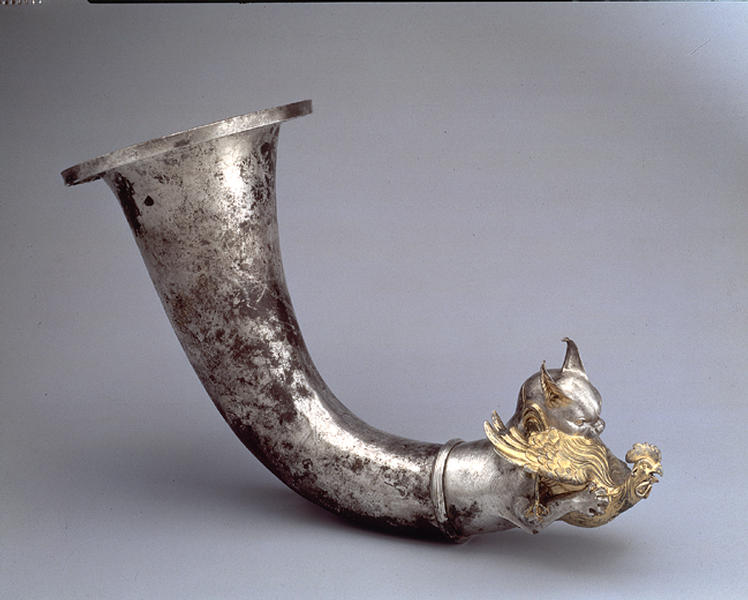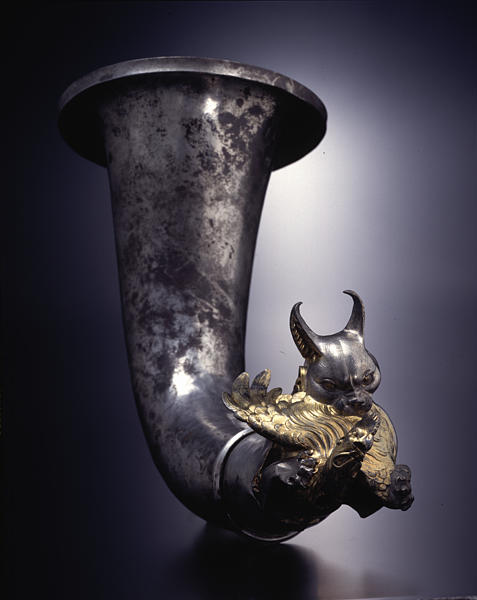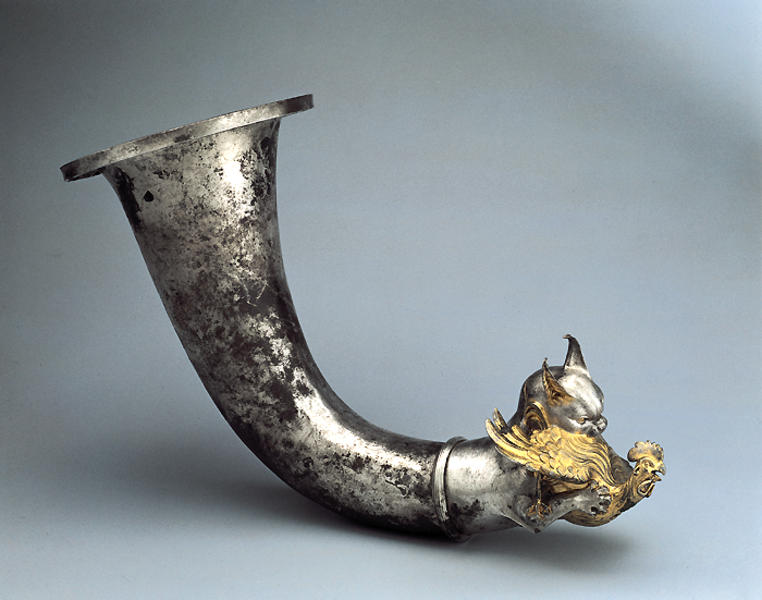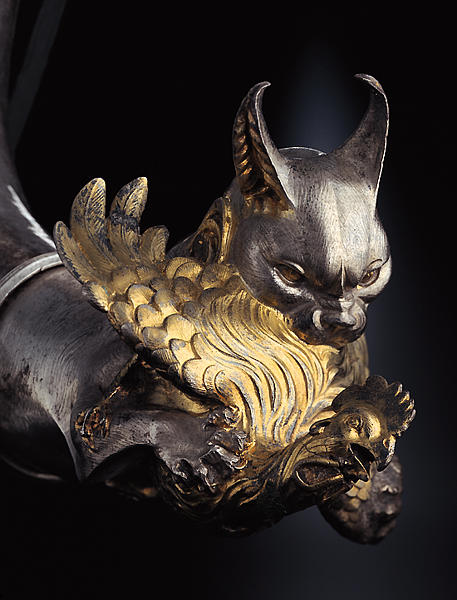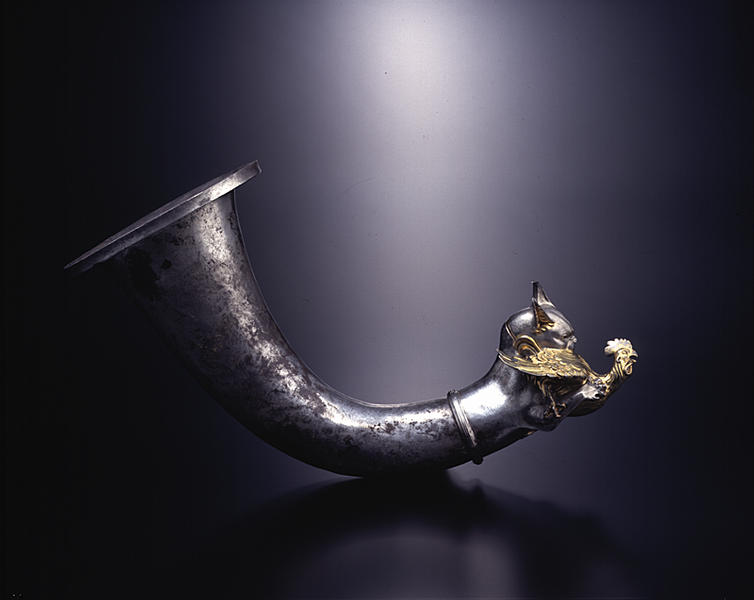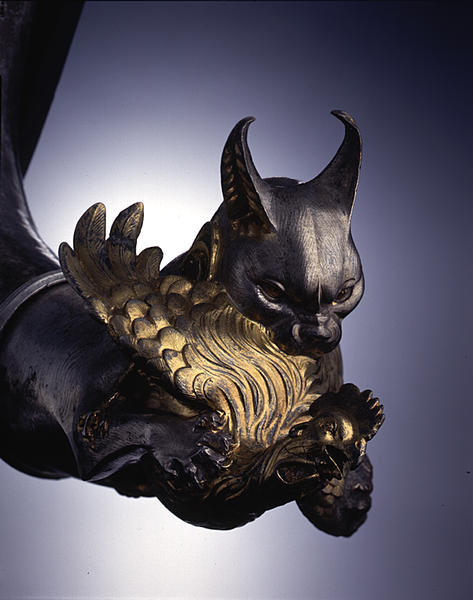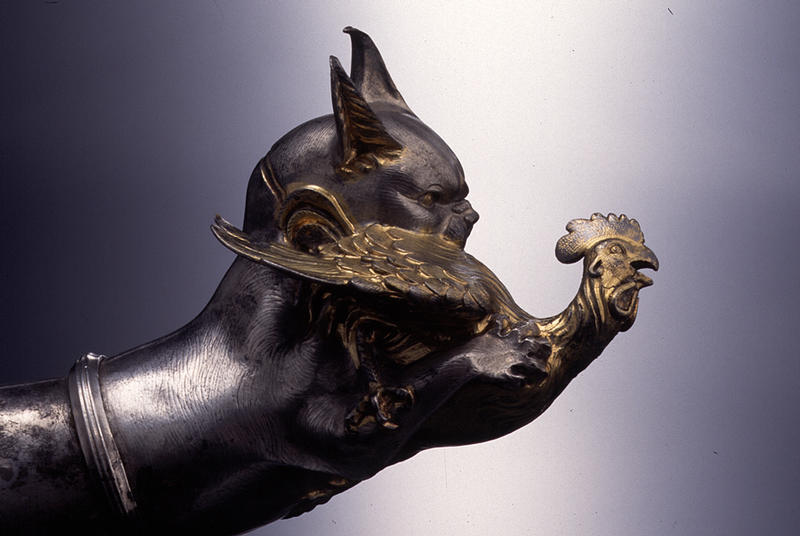Rhyton with the Protome of a Desert Lynx Catching a Fowl
- Iran or Central Asia
- Late 2nd - 1st century B.C.
- Gilded silver (Silver with gilding)
- H-41.4 D-15.4
Catalogue Entry
This stunning rhyton or drinking horn depicts the protome (forepart) of a desert lynx (caracal cat, Felis caracal) clutching a desperate cockerel in his paws. The rhyton is made in two major parts--the horn and separately manufactured protome of the lynx and bird. The slender horn rises to an outturned rim. A spout opens at the breast of the straining bird. The relentless intensity of the predator and the terror of his victim are brilliantly conveyed. The artist vividly alluded to motion by having the cat turn slightly to the right, the direction in which the bird tries to escape. Gilding is used to visually separate the animals. On the lynx it is limited to the eyes, inner ears, and collar, whereas the cock is completely gilded.
From a typological point of view, the idea of a feline catching or devouring his victim is based on an Achaemenid concept.1 An Eastern context for the rhyton is further corroborated by the lynx, because the examples with this animal known to date are almost exclusively linked to the Hellenized Near East. The style, however, follows Greek standards, without the slightest reference to Achaemenid art, making it a telling example of the craftsmanship from the Hellenized Near East.
Rhyta enjoyed a long history in ancient West Asia and were especially popular in the Achaemenid period (mid-sixth-third quarter fourth century B.C.). Lynx rhyta, however, were entirely unknown in the pre-Hellenistic Near Eastern repertoire. As in the case of all other known examples, the cats in this and a second lynx rhyton in the Shumei collection (SF3.034)2 wear a collar around the neck, which shows them to be tamed animals, possibly ones used for hunting by the Eastern nobility. Given the presence of ivy under the rim and a lavish spray of vine around the animal's neck in the second Shumei lynx rhyton--a motif also found on a lynx rhyton in New York--an even more specific background should be considered.3 Not only does the lynx closely resemble a panther, the holy animal of Dionysos, the Greek god of wine, the ivy was likewise a Dionysiac symbol. According to ancient mythology, the symposiastic god conquered the East and even reached India.4 As a conqueror of India, Dionysos must be understood as a divine forerunner of Alexander the Great and his Asian campaigns (335-323 B.C.). Given such Dionysiac aspects, we should see the lynx-panther rhyta as an allegory of Graeco-Macedonian dominance over the collapsed Achaemenid Empire. The Dionysian affiliation makes it rather unlikely that all these rhyta should be entirely limited to late Hellenistic days, when the Central Asian Parthians had already erased Greek power from Iran to Mesopotamia, but archaeological clues for an earlier dating are presently lacking.
This brilliant rhyton with lynx and cockerel must be understood as a variant of such Near Eastern lynx rhyta. All are without any recorded provenance. Two pieces in the J. Paul Getty Museum have been dated to the 1st century B.C. on the basis of their Aramaic inscriptions.5 Our rhyton carries two inscriptions studied by P.O. Skjaervo,6 the second gives the number 34. This should be a weight inscription, referring to a coin standard, but it may be one that differs from the standard used for the Getty vessels, which is based on a multiplier of 4. In this case a multiplier of 4 is much too small, and consequently Skjaervo suggested that this weight inscription may possibly refer only to the horn cup of the rhyton. One might consider, however, the hexa-chalkons (copper coins) of Demetrius I of Bactria (about 205-171 B.C.), the famous conqueror of India.7 The weight of one of these coins is approximately 25.5 grams, which multiplied by 34 (867 g) gives almost precisely the weight of the vessel (877.2 g). This is only a possibility and should not be taken to imply a definite clue towards absolute chronology, although historical and mythological considerations may actually point to an expansion of the chronological range beyond the usual preference for a late Hellenistic dating.
MP
1. See, for example, a rhyton with a protome of a lion catching an antelope, of Egyptian faience, which is in truly Achaemenid style, Paris, Louvre E 931: Roes 1952, pp. 17-20, fig. 4; and a unique glass rhyton from Persepolis, now in Teheran, of a lion killing a bull: Ghirshman 1961, p. 40, fig. 3. 4; Ghirshman 1962, pp. 77, fig. 26.
2. The second rhyton (reproduced Los Angeles County Museum 1996, n.p.) belongs to a well-documented group named "calyx class" after the leaf calyx behind the protomes. The calyx closely resembles the foliage on a lion rhyton of alleged Near Eastern provenance in the J. Paul Getty Museum, Malibu: Pfrommer 1993, pp. 47-48, 178-79, with ill; as well as on a rhyton with the protome of a cebu bull in the Toledo Museum of Art, 1988.23: Knudsen and Luckner 1991, pp. 115-18, figs. 1,2.
3. New York, Metropolitan Museum of Art 1979.447 (Parthian, about first century B.C.): Harper 1984, p. 16, fig. 13; Harper 1987, pp. 350-351, fig. 98; Pfrommer 1993, p. 48.
4. See, for example, Diodorus I.19, 1-5.
5. Pfrommer 1993, pp. 186-87, 190-91, no. 71, 73, with ills.
6. Metropolitan Museum 1996, p. 190.
7. Mitchiner 1975/76, vol. 1, p. 59, no. 107 (hexa-chalkon = 25.42 g).
Catalogue Entry(Bac#029,030)
29
Lynx Rhyton
1st century B.C.
Gilded silver
L. 44.0 cm, Mouth dia. 15.0 cm
30
Rhyton with the Protome of a Desert
Lynx Catching a Fowl
Late 2nd‐1st century B.C.
Gilded silver
L. 41.4 cm, Mouth dia. 15.2-15.4 cm
The silver rhyton at no. 30 shows the forequarters of a desert lynx catching a fowl in its paws, while the chest of the bird forms the spout. The entire figure of the bird is gilded and contrasts clearly with the cat's form, while the cat's eyes and the insides of its ears are also gilded. The long ears are pointed at their tips and curve in slightly as part of the expression of this powerful cat. There are several examples of Hellenistic jewelry with similar cat motifs from around the time of Christ. This cat is wearing a gilded collar, and this probably indicates that such animals were kept for hunting purposes during this period. The desert lynx is a Dionysian beast, and it is frequently shown alongside leopards. There are also several similar examples of rhyta with attached animal forequarters, and as can be seen in cat. No. 29, the lynx's body is decorated with vine and grape motifs, clearly indicating a deep relationship with the rites of Dionysus. And we know that the mystery of Dionysus included ritual vessels featuring this kind of hunting cat, such as a leopard or lynx. Similar examples in the J. Paul Getty Museum and the Sackler Gallery have the same kind of hair depiction on the animals' body, and a spiral motif on their shoulders. The curling hair motif on the lynxes on cat. Nos. 29 and 30 are not the same kind of motif. The lynx violently plunging and capturing the bird in such amazingly life-like form that we can almost feel the bird's surprise. A Greek craftsman with unparalleled skill created this motif which, in fact, originated in west Asia.
Lynx Rhyton
Rhyton with the Protome of a Desert Lynx Catching a Fowl
Eyes blazing, the lynx (caracal) firmly grasps its prey. The cockerel screams in desperation, eyelids flipped as its fate is sealed. Is there any other piece in the world that captures the workings of life and death with such arresting power? It is a superlative figure encapsulating the law of nature.
The caracal is known to have been used in hunting fowl in the ancient Orient, and the gilt gold of the collar seems to confirm this. The inscriptions on the rhyton indicate it was ordered by a nomadic Sarmatian, as the inscriptions include a unit of weight used by that tribe.
The Grecian artisans who had settled in Central Asia must sometimes have produced pieces that far surpassed the imagination of the customer.
